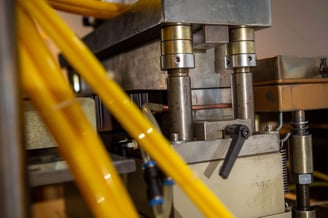Medical Trays: Uses, Types, Features, Costs & More

In busy healthcare environments, staying organized is key. Among the many tools used in medical procedures, medical trays are essential for keeping things running smoothly. Despite their importance, they're often overlooked. Medical trays are crucial for efficient procedures and patient safety. However, when they're not designed, sterilized, or used properly, they can hinder workflow and compromise patient care.
By understanding the critical role of medical trays and implementing best practices, their effectiveness can be enhanced. From optimizing organization to leveraging single-use trays, healthcare facilities can improve patient care. In this blog post, we'll look at what medical trays are, their types, uses, design features, and more.
What are Medical Trays?
Medical trays are essential tools in healthcare settings, designed to organize and facilitate various medical procedures efficiently. These trays typically consist of a sterile container or compartmentalized tray that holds medical instruments, supplies, and equipment needed for specific medical tasks or procedures.
The primary purpose of medical trays is to streamline workflow, improve organization, and ensure the availability of necessary resources during medical procedures. From simple wound care to complex surgical interventions, medical trays play a crucial role in enhancing patient care and safety. Medical trays come in various sizes and configurations to accommodate different medical specialties and procedures.
Types of Medical Trays and Their Uses
Medical trays come in a diverse range of types, each tailored to specific medical procedures and specialties. Here are some common types of medical trays and their respective uses:
Wound Care Trays: Designed for the management of minor wounds and injuries, wound care trays typically contain sterile gauze, adhesive bandages, antiseptic wipes, and other supplies needed for cleaning and dressing wounds.
Suture Removal Trays: These trays are used for the aseptic removal of sutures or stitches following a surgical procedure or wound closure. They typically include sterile scissors, forceps, gauze, and antiseptic solution for cleaning the wound site.
Catheterization Trays: Catheterization trays are used for urinary catheterization procedures, both in hospitals and outpatient settings. They contain sterile catheters, lubricating gel, drainage bags, and other supplies necessary for catheter insertion and management.
Surgical Trays: Surgical trays are comprehensive kits that contain a wide range of surgical instruments, sterile drapes, and other supplies required for specific surgical procedures. These trays are meticulously organized to ensure efficiency and sterility during surgery.
Emergency Trays: Emergency trays are equipped with essential medical supplies and equipment needed for emergency medical interventions, such as cardiopulmonary resuscitation (CPR) or airway management. They often include items like oxygen masks, airway adjuncts, syringes, and medications.
Importance of Sterilization in Medical Tray Preparation
Sterilization is a critical aspect of medical tray preparation, ensuring that the contents remain free from microbial contamination and safe for patient use. Here's why sterilization is essential:
- Patient Safety: Sterilization eliminates harmful microorganisms, including bacteria, viruses, and fungi, that can cause infections in patients. By ensuring that medical trays are sterile, healthcare providers minimize the risk of healthcare-associated infections (HAIs) and promote patient safety.
- Regulatory Compliance: Healthcare facilities are required to adhere to strict regulatory standards regarding the sterilization of medical instruments and equipment. Compliance with these standards is essential for maintaining accreditation and meeting legal requirements.
- Prevention of Cross-Contamination: Sterilization prevents cross-contamination between patients by eliminating pathogens that may be present on medical instruments and supplies. This is especially important in settings where multiple patients may be treated using the same equipment.
- Optimal Surgical Outcomes: In surgical settings, sterile instruments and supplies are crucial for achieving optimal surgical outcomes. Contaminated instruments can compromise the success of surgical procedures and increase the risk of postoperative complications.
Design Features for Efficient Medical Tray Organization
Efficient organization is essential for maximizing the effectiveness of medical trays in healthcare settings. Here are some key design features that contribute to efficient medical tray organization:
- Compartmentalization: Medical trays are often divided into compartments or sections to organize instruments and supplies systematically. Compartmentalization helps healthcare providers quickly locate the items they need during procedures, minimizing the risk of errors and delays.
- Clear Labeling: Clear labeling of compartments and individual items is crucial for easy identification and retrieval. Labels should be legible and prominently displayed to ensure that healthcare providers can quickly locate the desired items without confusion.
- Customization Options: Many medical trays offer customization options to accommodate specific procedural requirements or personal preferences. Healthcare providers can select the instruments and supplies they need for each procedure, ensuring that the tray is tailored to the task at hand.
- Sterile Packaging: Medical trays are typically packaged in sterile containers or wrappers to maintain sterility until the moment of use. Sterile packaging protects the contents from contamination during storage and transportation, ensuring that they remain safe for patient care.
Optimizing Medical Trays for Improved Healthcare Outcomes
We’ve been able to establish the fact that medical trays are very important tools used in healthcare settings because they play very important roles by ensuring efficient procedures and patient safety. Through proper organization, clear labeling, and adherence to sterilization protocols, medical trays can streamline workflow, minimize errors, and contribute to better patient outcomes. Additionally, embracing the benefits of single-use trays offers convenience, cost-efficiency, and enhanced infection control measures.
As healthcare providers continue to prioritize patient safety and quality of care, the role of medical trays will remain indispensable. For high-quality medical trays and other ready-made plastic solutions, visit Ready-Made Plastics. Browse through our products and get in touch with us today!



